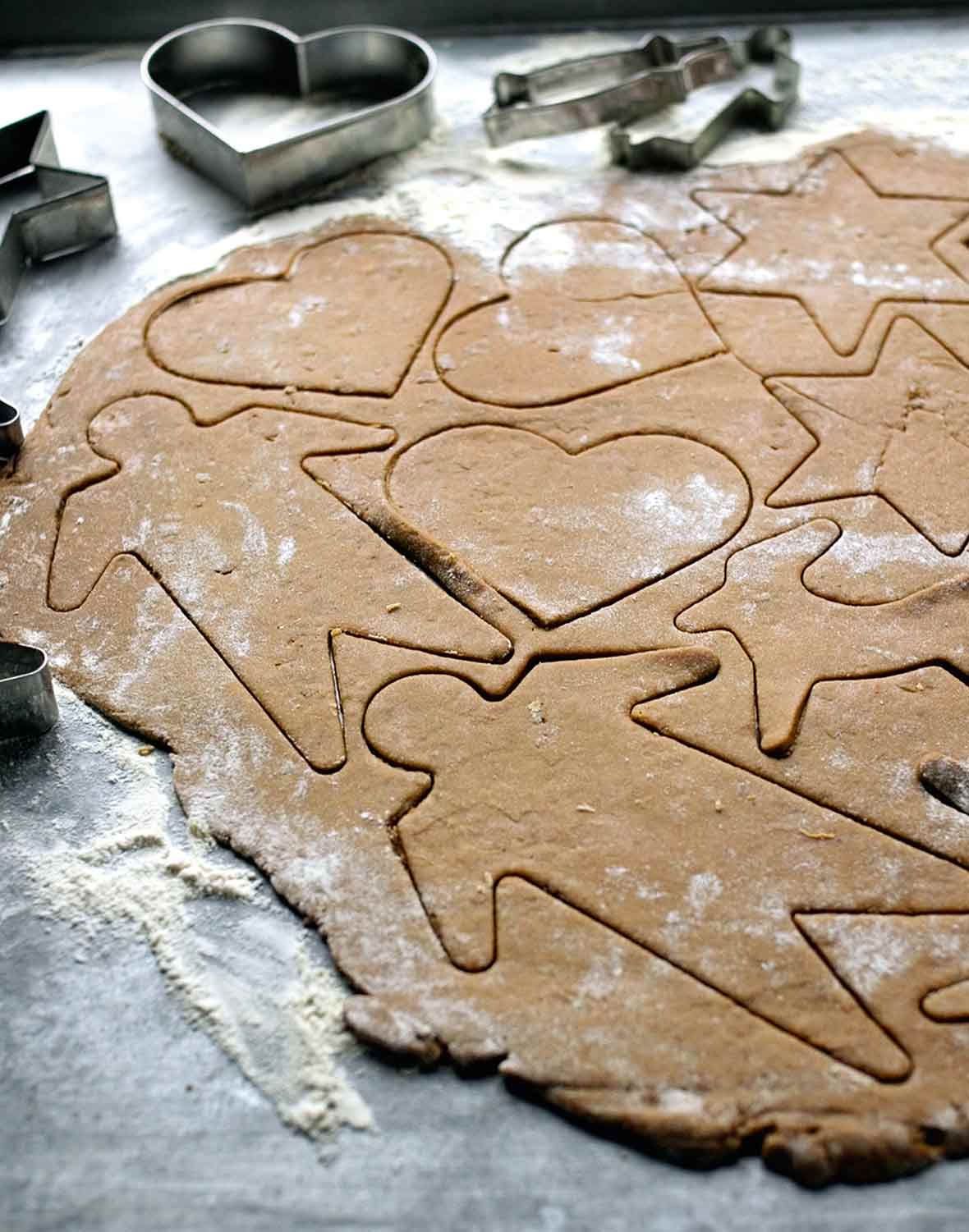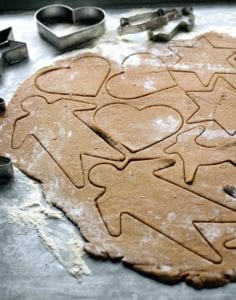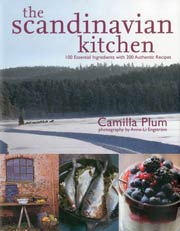
If you know Astrid Lindgren’s world-famous children’s books, you will recognize these Swedish black pepper cookies known as pepparkakor, which actually contain black pepper. The lovely crispy and spicy cookies are cut out of a thin layer of dough and then decorated with royal icing. The cookie cutters in Scandinavia are in the shape of men and women, the mythical creatures Nisse or Tomte–pigs, reindeer, and the only really scary animal in Nordic Christmas lore, the horned billy goat. Hearts, stars, and bells are popular shapes, too. The dough is very easy to make, and can also be shaped into pebernødder (“pepper nuts”), small, round, crispy cookies the size of a hazelnut. They are always extremely popular with children, and easy to shape even for a two-year-old. The traditional way to decorate them is to frame the cookie with icing, make buttons, shoes, and so on, or to write the family’s names on heart-shaped cookies and hang them in the windows on red ribbons.–Camilla Plum
LC Um, Pepper Cookies? Note
No single ingredient or title can do justice to these lovely, crisp, slightly spicy cookies that also contain cinnamon and cardamom and cocoa and ginger to mitigate pepper’s pungent warmth. Quite simply, you must try them. Photo: Janet Stein.

Black Pepper Cookies
Ingredients
- 2 sticks unsalted butter, at room temperature
- 2 1/2 cups sugar
- Generous 3/4 cup heavy cream
- Generous 3/4 cup corn syrup
- 2 tablespoons baking powder
- 4 teaspoons ground ginger
- 4 teaspoons ground cinnamon
- 4 tablespoons cocoa powder
- 4 teaspoons ground cardamom
- 2 teaspoons ground black-pepper
- About 8 cups all-purpose flour, plus more for the work surface
- Royal icing
Instructions
- Beat the butter and sugar in the bowl of a standing mixer or with a handheld electric mixer. Stir in the cream, then the rest of the ingredients except the flour. Add the flour and stir just until the dough is no longer sticky. Knead the dough on a lightly floured surface, then shape it into a disk, wrap it in plastic wrap, and let it rest in the refrigerator until the next day.
- Preheat the oven to 350ºF (176°C).
- Roll the dough on a lightly floured surface to a very thin sheet (1/8-inch thick is fine) and cut it into shapes. If any cookies are destined for hanging on the tree, pierce holes in the top of the cookies using the tip of a wooden skewer. Arrange the cookies on baking sheets lined with parchment paper. Reroll the dough until the last scrap is used. Bake in the oven until golden at the edges, about 12 minutes; a little less if chewy cookies are desired, a little more if crisp cookies are preferred.
- Decorate with royal icing. The traditional way is to frame the cookie, make buttons, shoes, and so on, and to write the family’s names on heart-shaped cookies and hang them in the windows on red ribbons. Store the cookies in airtight tins for up to several weeks (yes, you read correctly, weeks!).

Nutrition
Nutrition information is automatically calculated, so should only be used as an approximation.
Recipe Testers’ Reviews
I was a little afraid of this recipe, having not tried to rival my Swedish mother’s “Pepparkakor,” or gingerbread cookies, prior to this baking. I’m happy to report the black pepper cookies were a terrifically successful variation on this Swedish classic. Both the taste and the aftertaste have a nice spicy tone. I missed the cloves of my mother’s version just a bit, but liked the inclusion of black pepper and cocoa powder. The dough came together with ease. After chilling, I found I needed to bring the temperature up a bit to avoid cracking while I rolled it out, but once it was a bit warmer, it was easy to work with. I baked for 10 to 12 minutes and flipped the trays halfway. Bake only until there is just the smallest amount of golden brown visible: these cookies are not intended to be browned like butter cookies. For a slightly less crisp cookie, I think a minute or so less baking would still provide authentic texture, without veering toward crunchy. Although the gingerbread cookies of my childhood were thinner and more delicate than these, the sturdiness is a positive feature, allowing complicated shapes to be made without undue fear of breakage. And they could potentially also travel well, a real plus for the winter holiday season.
For extra-precision, especially with detailed shapes, it’s a good idea to place the cookie sheet in the fridge for 15 to 20 minutes, and then place it directly in the oven; the cookies will retain their shape better this way. This is a great cookie to pierce and hang, as described, since it is sturdy enough to hold up to treatment as a decoration. I would never ice a gingerbread cookie, but I will decorate a bit with currants or almonds when I roll out and bake the rest of the dough.
The dough is a long-term keeper: simply wrap well (I use a double layer of plastic wrap followed by a layer of heavy duty aluminum foil) and refrigerate. Then remove when ready to bake a tray or two — or more! This recipe will make a lot of cookies: how many depends on the size of the cutters used. The dough scraps can be re-rolled over and over again until they are no longer rollable. In the case of my test recipe, I re-rolled one piece of dough four times with success and only stopped re-rolling it because the scraps became too small. Not only will the dough keep well, but the baked cookies will also keep well. I remember my mother baking gingerbread cookies among the first batches of the holiday season, then storing the cookies in very tightly sealed cookie tins. In the unlikely case there are any left over when ringing in the New Year, they will still be fresh and tasty if carefully stored. And, though Americans see these cookies nearly exclusively as a holiday treat, they are not only a Swedish classic but also a Swedish standby. My mother used them as her year-round go to, in the same way Americans might make sugar or butter cookies, or chocolate chips. In Sweden, while the shapes might change seasonally, gingerbread cookies are never out of season. I needn’t have feared this recipe. Quite the contrary, it brought back lots of terrific childhood memories — memories of my kitchen and my mother and lots of lots of holiday festivities and Swedish traditions, all floating through my mind as the lovely aroma wafted through my kitchen.
These are excellent all-around spice cookies. The pepper gives them just enough kick, but not so much that my (fairly picky) toddler would reject them. The black pepper cookies are crisp and sturdy enough to be mailed or made into ornaments, and they keep very well. A note on the color: owing to the cocoa powder I used, my cookie dough was quite dark, and the baked cookies were almost a mahogany color. I settled on a 12-minute baking time. The yield is indeed a lot. Half of the recipe yielded seven dozen 2 1/2″ round cookies, including rerolled scraps.
I was in search of the PERFECT unusual, cookie to take to my first Christmas exchange. I was to be the first male attendee in a decade-old affair, so I needed to “hit one out of the park,” so to speak. I needed twelve pounds of cookies, so I rolled the dough into one-inch ropes and cut them into one-inch knots and after baking I merely shook them in confectioners’ sugar. They were wonderful. Trust me, if you enjoy a great spice cookie, look no further.













Hi – I have two questions. (1) I would like to use honey rather than corn syrup in this recipe. Will it work as well and, if so, should I use a 1 – to – 1 ratio, or some other ratio? And (2) I cannot eat chocolate or cocoa (they trigger migraines), so should I add the equivalent amount of flour, and possibly ramp up the spices, to compensate for omitting the cocoa, or would you recommend just omitting the cocoa?
Thanks.
Great questions, Lynn. You can substitute honey for the corn syrup with a 1:1 ratio. For the cocoa, I would omit it, and then when you are rolling your dough, flour as much as necessary to avoid a sticky dough. If the dough is very sticky before rolling, work in some additional flour first.